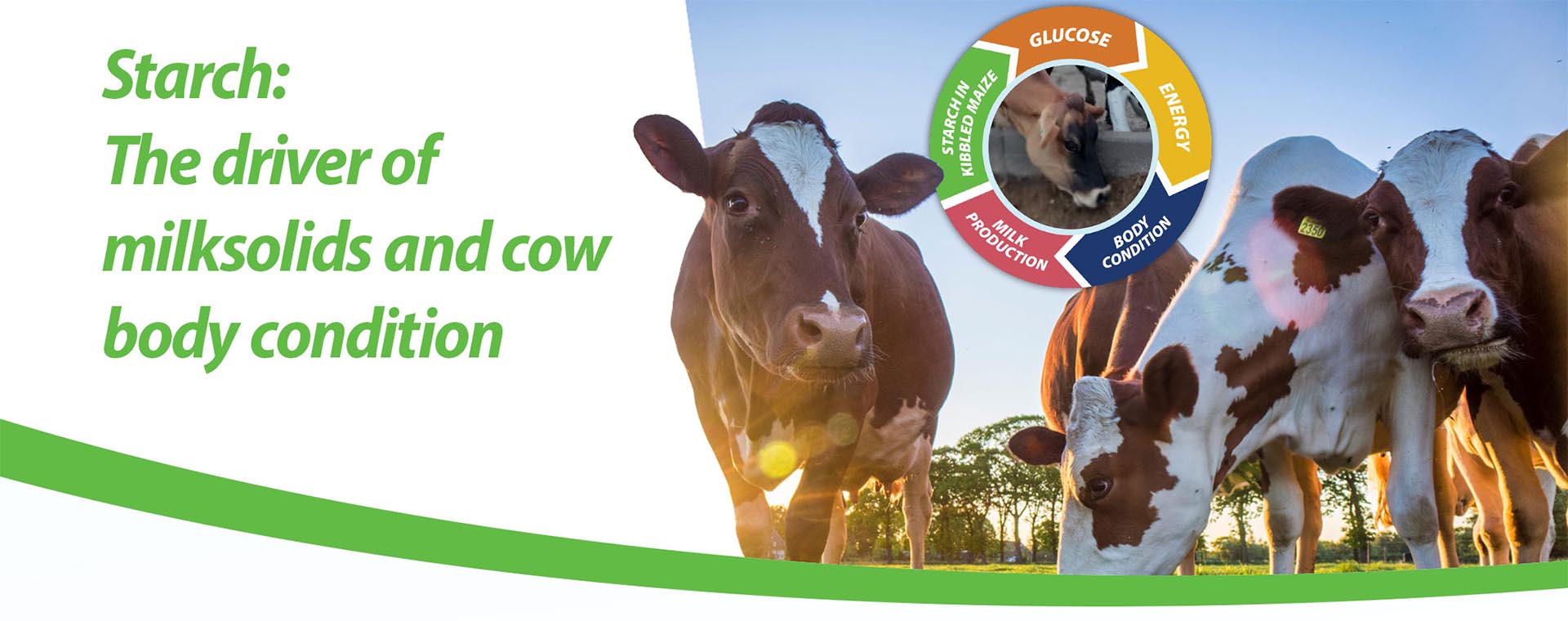
As an industry, we’ve come a long way since we valued feed simply on a dry matter (DM) basis. Megajoules of metabolisable energy (MJME) is the industry standard way to define feed quality. Ranking feeds from high to low MJME/kgDM helps prioritise the very best feeds for high demand stock classes. Dietary starch is the next most valuable way to rank value of a feed, for lactating dairy cows, particularly.
What’s the role for starch in the diet of dairy cows? As part of an overall balanced diet, starch is the key to unlocking improved milk production and/or better cow body condition.
A better supply of glucose to the cow is the key benefit of dietary starch. Rumen microbes convert dietary starch to propionate, an extremely useful volatile fatty acid (VFA). Propionate moves from the rumen to the liver where it is converted to glucose. Export of glucose from the liver into the blood drives three important outcomes for lactating dairy cows.
Milk lactose manufacture by the udder needs plenty of blood glucose. Milk volume is driven by lactose production by the udder. More blood glucose yields more milk lactose, which in turn yields more litres of milk.
1. Improve Supply of Glucose to the Cow
A better supply of glucose to the cow is the key benefit of dietary starch. Rumen microbes convert dietary starch to propionate, an extremely useful volatile fatty acid (VFA). Propionate moves from the rumen to the liver, where it is converted to glucose. Export of glucose from the liver into the blood drives three important outcomes for lactating dairy cows.
Milk lactose manufacture by the udder needs plenty of blood glucose. Milk volume is driven by lactose production by the udder. More blood glucose yields more milk lactose, which in turn yields more litres of milk.
2. Improve Milk Protein Production
Improved milk protein production is the second benefit of feeding dietary starch. If the blood glucose supply is limited, the liver of the cow converts amino acids (components of protein) into glucose. Fewer amino acids available to the udder mean less milk protein manufacture. More dietary starch means more propionate and glucose, ‘sparing’ the need for the liver to breakdown amino acids to yield glucose. More amino acids become available for milk protein manufacture.
3: Body Condition Gain
Body condition gain or sparing of body condition loss is the third key benefit of starch. A shortage of glucose in early lactation causes cows to mobilise fatty acids from back fat to use as an alternative energy source to glucose. Propionate from starch ‘holds up’ blood glucose levels, reducing reliance on the mobilisation of back fat. Late lactation cows convert surplus blood glucose into back fat, improving body condition gain before drying off.
The starch content of feeds is not equal. In a similar way to comparing feeds on a MJME basis, we can compare feeds on a starch basis. Pasture and pasture silage contain very low levels of starch. Maize silage contains starch up to 35% of DM. The starch content of cereal silage is variable, from less than 10% up to 25% of DM.
Cereal grains remain the industry ‘gold standard’ as excellent sources of starch. The Starch content of cereal grains varies, for example, maize (70-75% starch), wheat (58-70% starch) and barley (50-60% starch).
Assessing the Value of Starch Across Different Feeds
Different dairy feeds can be valued and compared on a $ per tonne of starch basis. The calculation is straightforward. Divide the price of a feed per tonne of DM (t DM) by the percentage of starch in a feed. If barley grain is landed on farm at $500 / t, include a processing cost / t, then convert to $ / t DM. E.g. $500 / t landed on farm plus $50 /t processing equals $550 / t. Divide by the DM percentage (e.g. 86%) equals $640 / t DM. Divide $640 / t DM by 55% starch equals $1162 / t starch.
In contrast, compare the starch content of a purchased blended feed. If a blend is landed on farm at e.g. $700 / t, there’s no processing cost, convert to $ / t DM. For example, $700 divided by 90% DM = $778 / t DM. Divide $778 by e.g. 25% starch = $3112 / t starch.
Equation for $ of Starch/Tonne of Grain:

Click here for more information about feeding grain.
For grain orders and enquiries click one of the three links below: